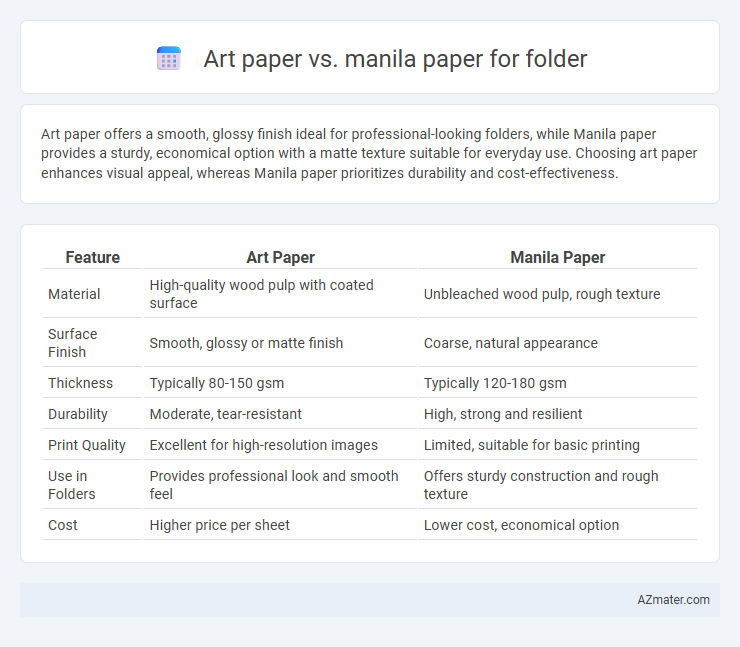Art paper offers a smooth, glossy finish ideal for professional-looking folders, while Manila paper provides a sturdy, economical option with a matte texture suitable for everyday use. Choosing art paper enhances visual appeal, whereas Manila paper prioritizes durability and cost-effectiveness.
Table of Comparison
| Feature | Art Paper | Manila Paper |
|---|---|---|
| Material | High-quality wood pulp with coated surface | Unbleached wood pulp, rough texture |
| Surface Finish | Smooth, glossy or matte finish | Coarse, natural appearance |
| Thickness | Typically 80-150 gsm | Typically 120-180 gsm |
| Durability | Moderate, tear-resistant | High, strong and resilient |
| Print Quality | Excellent for high-resolution images | Limited, suitable for basic printing |
| Use in Folders | Provides professional look and smooth feel | Offers sturdy construction and rough texture |
| Cost | Higher price per sheet | Lower cost, economical option |
Understanding Art Paper and Manila Paper
Art paper, known for its smooth texture and glossy finish, offers high-quality print results, making it ideal for professional folders that require vivid colors and sharp images. Manila paper is a sturdy, coarse-textured material often used for basic folders due to its durability and cost-effectiveness, though it lacks the refined surface of art paper. Understanding these differences helps in choosing the right paper type based on folder usage, from premium presentation folders to everyday organizational needs.
Composition and Material Differences
Art paper is made from high-quality wood pulp with a smooth, coated finish that enhances print sharpness and color vibrancy, making it ideal for professional folder covers. Manila paper consists of recycled fibers, primarily from Manila hemp, resulting in a coarse, uncoated surface that emphasizes durability and cost-effectiveness but offers limited print quality. The composition differences between art paper's bleached, coated cellulose and manila paper's natural, fibrous texture significantly impact their appearance, texture, and suitability for folder applications.
Durability and Strength Comparison
Art paper offers a smoother finish and higher print quality but lacks the durability and tear resistance of Manila paper, which is thicker and more robust. Manila paper, typically made from sturdy hemp or jute fibers, provides enhanced strength ideal for folders that require frequent handling or heavier contents. The superior tensile strength and resistance to creasing make Manila paper the preferred choice for durable folder construction.
Texture and Finish: Smoothness vs Coarseness
Art paper features a smooth texture with a glossy or matte finish, ideal for vibrant prints and professional presentation folders. Manila paper has a coarser texture and a natural, uncoated finish, providing durability and a rustic look for folders. The smoothness of art paper enhances color sharpness, while the coarse surface of Manila paper offers better grip and a handmade feel.
Color and Aesthetic Appeal
Art paper offers a smooth, glossy finish that enhances vibrant colors and gives folders a polished, professional look, ideal for high-impact presentations. Manila paper provides a natural, earthy tone with a matte texture, catering to rustic or casual aesthetics while allowing for easy customization. Choosing between art paper and manila paper depends on the desired color vibrancy and the folder's overall aesthetic appeal.
Cost and Budget Considerations
Art paper offers a smooth finish and vibrant print quality, but comes at a higher cost compared to Manila paper, making it less budget-friendly for large-scale folder production. Manila paper is economical and durable, suitable for bulk folder printing when cost efficiency is a priority without compromising basic functionality. Choosing between art paper and manila paper depends on balancing aesthetic requirements with budget constraints for folder manufacturing.
Suitability for Printing and Writing
Art paper offers a smooth, coated surface ideal for high-quality, vibrant printing and detailed images, making it highly suitable for professional folder presentations. Manila paper features a rougher texture and absorbs ink more readily, which is better suited for handwriting or lower-resolution printing but may cause ink to bleed or appear less sharp. Choosing between art paper and manila paper depends on the desired finish and printing precision required for the folder.
Environmental Impact and Recyclability
Art paper, typically coated and treated for smoothness and print quality, often contains chemical additives making it less environmentally friendly and more challenging to recycle. Manila paper, derived from natural fibers with minimal processing and no added coatings, exhibits higher biodegradability and simpler recyclability, reducing its environmental footprint. Choosing manila paper for folders supports sustainable practices due to its organic composition and compatibility with standard recycling processes.
Popular Uses for Folders: Art Paper vs Manila Paper
Art paper is favored for folders requiring a smooth, glossy finish that enhances printed graphics and vibrant colors, making it ideal for presentation folders and marketing materials. Manila paper, known for its durability and cost-effectiveness, is commonly used for bulk filing folders and everyday office organization due to its sturdiness and resistance to tearing. Both papers cater to different folder applications, with art paper excelling in visual appeal and manila paper providing practical functionality.
Choosing the Right Paper for Your Folder Needs
Art paper offers a smooth, glossy finish ideal for vibrant color reproduction and professional presentation in folders, enhancing visual appeal. Manila paper provides a sturdy, cost-effective option with a matte, textured surface suitable for everyday use and increased durability. Selecting the right paper depends on the folder's purpose: choose art paper for high-quality presentations and manila paper for practical, budget-friendly storage solutions.

Infographic: Art paper vs Manila paper for Folder
 azmater.com
azmater.com